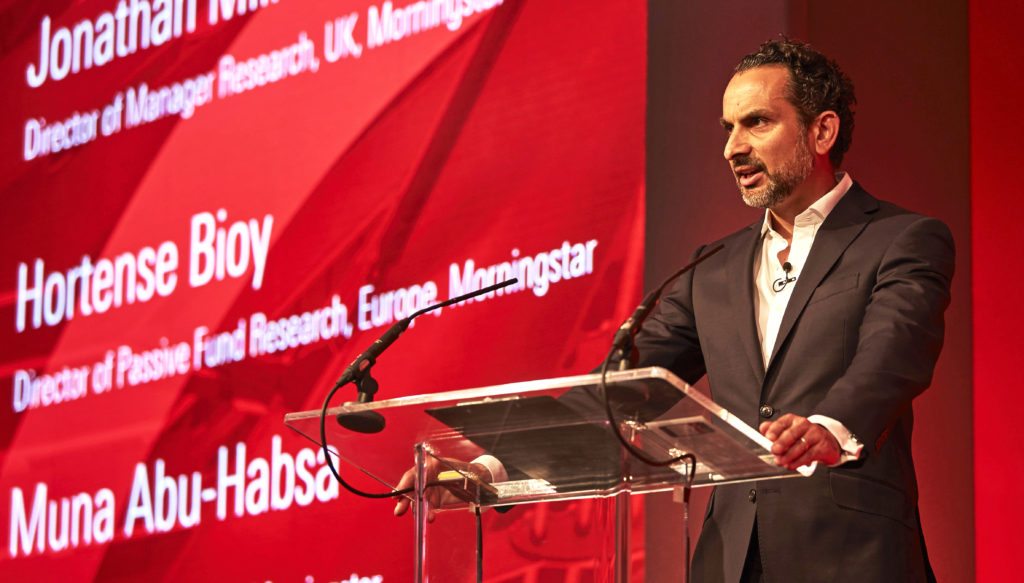I’ve attended the Morningstar Investment Conference in London every year in May since its inception in 2006, and I’ve seen its popularity rise during that time from an initial 50 or so delegates to somewhere close to 500 this year, making it one of the UK’s premier financial conferences. But this year, my 11th consecutive, it was different because in addition to having the customary opportunity to listen and learn from a diverse range of leading speakers over the course of two days, I’d also been invited by Morningstar to contribute to the proceedings myself by moderating a panel debate on the big stage for the benefit of the attending financial advisers, wealth managers, and investment professionals.
Now Morningstar Inc. for those of you who don’t know, is a leading provider of independent investment fund research, offering detailed analysis, thought leadership and products to help investors and advisers reach better investment outcomes. They’re not investment providers, alternatively standing as an independent voice when it comes to matters of investment, and as a global company with over 4,500 employees in 27 countries worldwide covering over 500,000 investments, Morningstar has consistently produced credible, trustworthy, investor focussed insight and guidance for over 30 years. Morningstar likes to say ‘Investors first’ and you can find out more about them here.
Attending the conference each year is a great opportunity for me to hear directly from a broad range of the financial industries leading contributors who can challenge my own perspective of the financial and advisory business. Whether it’s an economist’s detailed review of the recent factors affecting the global economy, the insights to be learnt from the latest academic research paper, legislative and regulatory guidance from technical experts, or the thoughts of leading investment fund managers, the conference is designed to keep me informed of the latest thinking and relevant developments, so that I can help our clients make the best investment decisions possible. It’s also an opportunity for me to meet and maintain relationships with other financial practitioners, Morningstar’s dedicated fund analysts and software support staff who’s extensive products we subscribe to and use almost daily to help deliver advice.
And it’s because of my long standing relationship with Morningstar and a mutual respect that I got an email from them asking whether I’d like to help deliver a message at this year’s conference. I didn’t hesitate to say yes.
Amongst the numerous tools that Morningstar produces, the ‘Analyst Rating’ is a relatively new development having been introduced in 2011. The rating is Morningstar’s unbiased professional assessment of the overall quality of an investment fund based on various research ‘pillars’ and it can be used by investors and advisers to help choose superior funds to meet their investment objectives and portfolio needs. By giving a fund a gold, silver, bronze, neutral or negative analyst rating, the lengthy, in-depth analysis and detailed research process required to competently assess a fund can be simplified into an easily understandable rating. However, the ‘methodology’ behind the rating, the resources needed, the access to asset managers required to make a judgment, and the correct usage and interpretation of the ratings by investors and advisers alike still need to be fully understood to get the best out of the system.
On that basis, it was suggested to me that as an adviser and regular user of the ‘analyst rating’ myself, it would be helpful to conference attendees if I could moderate a panel discussion delivering investor and adviser specific questions to a panel of Morningstars top fund research experts including Jonathan Miller – Director of Fund Reseach, Hortense Bioy – Director of Passive Funds Research and Muna Abu Habsa – Head of Ratings, with the intention of talking through a full explanation of the analyst ratings.

And so, with a couple of preparatory meetings, some email conversations in advance of the conference, and my preparation of some difficult questions for the panel, the day to speak came quickly. Now, I’d be lying if I said that I wasn’t a little nervous, especially considering the size and knowledge of the audience, but once I’d delivered the intro and we were up and running my biggest problem was actually running out of the allotted time more than anything else. The conversation was flowing and it seemed to be going pretty smoothly but with 35 minutes set for our slot, I looked at the on stage timer to find I was drastically running out of time. With more time I think that we could have got to the bottom of a lot more than we actually did but in the end, I think we accomplished what we’d set out to do and with a few final audience questions resolved by the panellists and a quick conclusion by me, it was all over as quickly as it had began.
And with the evening drinks reception an opportunity to further discuss the day’s events, it was clear from the feedback that our discussion had been well received. I thoroughly enjoyed taking part and look forward to attending the conference in 2018. With thanks to Morningstar for the invitation and who know’s, next year I might go to Morningstar’s showcase Chicago conference instead if they’ll have me?
Follow me on Twitter @alexandreriley

